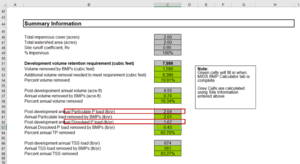
Difference between revisions of "Adjusting dissolved and particulate phosphorus ratios in the MIDS Calculator"
(Created page with "{{alert|This guidance is applicable to filtration practices (e.g. practices with an underdrain, filter strips, swales, sand filters). Infiltration practices are considered to...") |
|||
| Line 6: | Line 6: | ||
==Case 1: adjusting phosphorus ratios across an entire site== | ==Case 1: adjusting phosphorus ratios across an entire site== | ||
| + | [[File:Emc screen shot.png|300px|thumb|alt=Screen shot showing the site event mean concentration (emc)|<font size=3>Screen shot showing the site event mean concentration (emc)</font size>]] | ||
| + | [[File:Site adjustment screenshot.png|300px|thumb|alt=screen shot showing where to adjust DP and PP fractions on the '''''Site Information and Summary''''' tab|<font size=3>Screen shot showing where to adjust DP and PP fractions on the '''''Site Information and Summary''''' tab</font size>]] | ||
| + | |||
{{alert|This case applies to a situation where you are adjusting the ratios across an entire site rather than for individual treatment practices (bmps). If you are adjusting ratios for the different practices at a site, see Case 2 below.|alert-info}} | {{alert|This case applies to a situation where you are adjusting the ratios across an entire site rather than for individual treatment practices (bmps). If you are adjusting ratios for the different practices at a site, see Case 2 below.|alert-info}} | ||
Revision as of 23:09, 14 March 2023
Phosphorus in stormwater runoff occurs in particulate and dissolved forms. Many stormwater practices are effective at removing particulate phosphorus, but many are ineffective for removing dissolved phosphorus. In addition, the dissolved phosphorus (DP) and total phosphorous (TP) loads for a site vary depending on several factors, such as land use (residential, commercial, and industrial), time of year, and precipitation amounts and patterns. To accurately model pollutant loading at a site, it may therefore be important to accurately assign these ratios. See this page for more information on phosphorus.
This page describes how to adjust the dissolved phosphorus to total phosphorus (DP:TP and the particulate phosphorus to total phosphorus (PP:TP) ratios in the MIDS Calculator.
Case 1: adjusting phosphorus ratios across an entire site
The Minimal Impact Design Standards (MIDS) calculator assigns a single value across a site for fractions of total phosphorus that are in dissolved and particulate forms (45 and 55 percent, respectively). These values can be adjusted by changing the value fields within the Excel spreadsheet that the MIDS calculator creates. To change the dissolved phosphorous to total phosphorous ratio for a site (DP:TP) follow these instructions:
- Ensure your event mean concentration (emv) is accurate for the conditions that are being modeled. The default value in the calculator is 0.3 mg/L. For more information on emcs, link here.
- Open the MIDS Excel file you are adjusting. This is done in Excel, not in the MIDS Graphical User Interface.
- Under the “Site Information and Summary” tab in the MIDS Excel spreadsheet change cell C60 to the desired particulate fraction. The default is 0.55.
- Under the same tab, “Site Information and Summary”, change cell C62 to the desired dissolved phosphorous fraction. The default is 0.45.
- Save the file and close it.
When you open the MIDS calculator GUI, the Results tab will show results for the site and for the individual bmps. The Summary Information accurately reflects phosphorus on the site. However, the individual BMP information under BMP Summary will not be accurate as you did not change the fractions for these. If you want accurate information for the individual bmps, you must adjust the individual bmps as described below in Case 2.
Case 2: adjusting phosphorus ratios for individual bmps
{{alert|If you change the fractions for any of the BMPs and want to know the pollutant load balance on the entire site, when you look at the “Results” tab in the MIDS calculator, do not look at the site summary information but look at the individual BMP summaries. Note: The term “leaf drop” implies fall when the leaves are falling.

